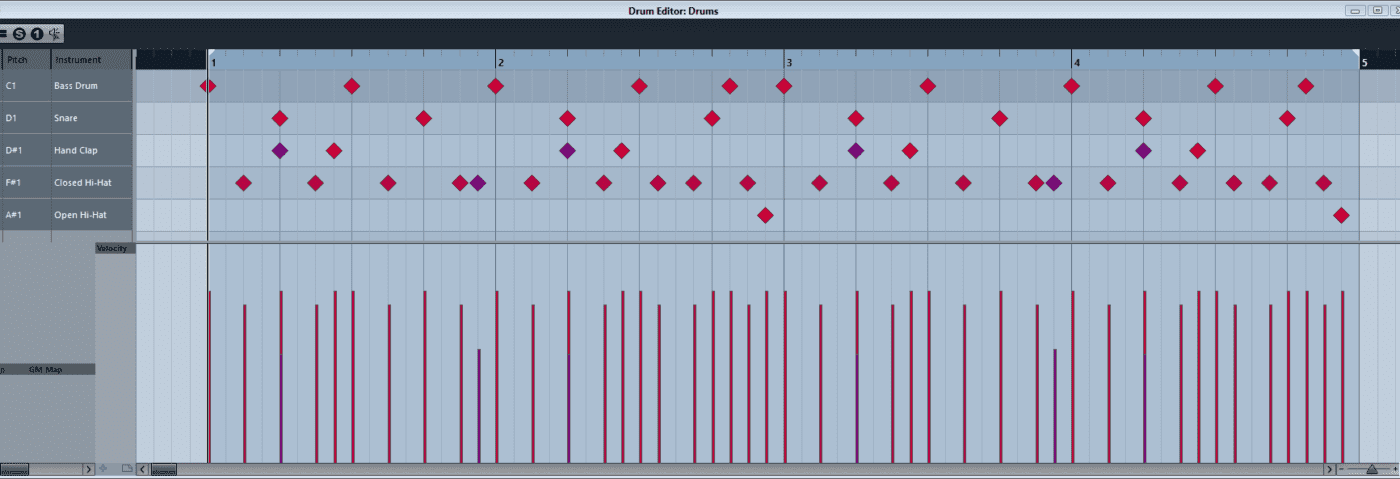Long Tail Theory
When we hear sounds, our auditory system uses an averaging system to determine relative loudness. The averaging ‘window’ can be as long as a second. Tests have shown that up to this point, noise bursts of constant sound pressure level but increasing duration appear to get progressively louder. Rhythmic material is particularly suited to making use of this psychoacoustic effect given the short duration of all but the most bombastic orchestral percussion.
Here we’re sticking to hi-hats once again, but this time we’re varying their decay. The hi-hats from before have been bounced to an audio track, sliced and edited:
Again, a more complex pattern of hat length/decay makes for a varying and interesting groove:
Applying small pitch variations can also be used to add interest to a simple drum pattern. However, in this case, there is somewhat of a conflict going on. Pitching a sampled sound higher usually involves playing it back faster. Faster playback means a shorter duration, and therefore a lower perceived loudness. At the same time, it has an enhanced high frequency content, often interpreted as a nearer source. Here’s the effect when every other sample is higher:
And again a more complex example:
This effect obviously doesn’t work exactly the same in all cases. Analogue drum machines are a case in point, where pitch and amplitude envelope are not intrinsically connected.





09.08 AM
Absolut brilliant article!!!
But 3 soundsamples doesn’t work on page 4:
– early snare
– late snare
– early hats
cheers
09.10 AM
Thanks, Now it’s working 🙂
01.43 AM
I don’t think it’s accurate to say jitter is inherent in midi. Jitter is a much worse problem than not being able to play two notes at exactly the same time. It means that there is a degree of random inaccuracy in the timing of every single midi event. Usb midi interfaces usually have some jitter. Regular midi over a midi cable doesn’t have this issue. And expert sleepers makes a good solution for getting sample accurate midi out of a computer (via spdif, not usb).
11.34 AM
Am i completely deaf in this regard – the first two samples, no swing vs swing, sound the same to me? Can someone highlight what I should focus on here to pick up this difference?
04.12 PM
Nice! Worth reading 🙂
01.22 PM
Plyphon – the effect is quite subtle in this case but if you compare the screengrabs you’ll be able to see which hits are slightly shifted.
You can find a lot more about swing here: http://www.attackmagazine.com/technique/passing-notes/daw-drum-machine-swing/
10.26 PM
For a (good) musician it is quite obvious to vary in velocity and in pitch regardless of which instrument. Try to listen carefully to a piano pop song and you will easily hear it wether a douchbag programmed the piano or a real piano player was playing. If the douchbag programmed it, every note will have the same velocity – there is no groove and no feeling for the 1’s of a quarter.
It just feels very unnatural to play every note at the same velocity. For instance a piano player has to create groove and emphasis the first note of a quarter and fill in the dynamic ‘gaps’ if the singer is inhaling or is quiet. Try to support the first note of a quarter and make it louder than the others.
Especially drum players know much more about emphasis of notes. for example so called 3er groups.
Anyway I would recommend just try to feel the groove .. listen carefully and stop thinking just let your foot decide wether it’s good or bad way you set the accents / emphasis.
Good example of techno with emphasis:
https://soundcloud.com/pinkmanrecords/pnkmn08-annanan-antagonism-ep
10.38 PM
Don’t forget that changing the pitch of a sample doesn’t just change the perceived loudness in terms of sample length, it also changes the perceived loudness based on the change in frequency content. It’s a psychoacoustic effect and the reason why 20 Hz and 16+ kHz seems quiet but the frequencies between, especially 2-3kHz, seem louder. The sample may be shorter when you pitch it up, but the perceived loudness could increase or decrease based on the sound level and position in the Fletcher-Munson curves.
07.09 AM
Danny – yes that’s right. However, most of the pitch changes used for the drums here are very small, so I don’t think the effect will particularly noticeable in this instance.